Art Teacher Resume Examples
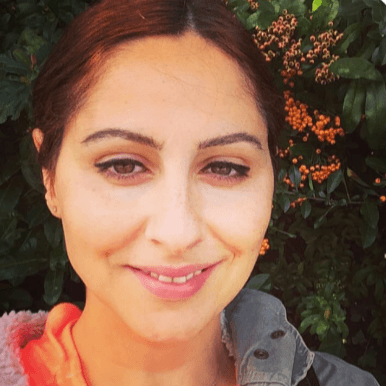
Jul 18, 2024
|
12 min read
"Master the art of your art teacher resume: create a canvas of your skills and experiences that will make schools paint you as their top candidate."
Rated by 348 people
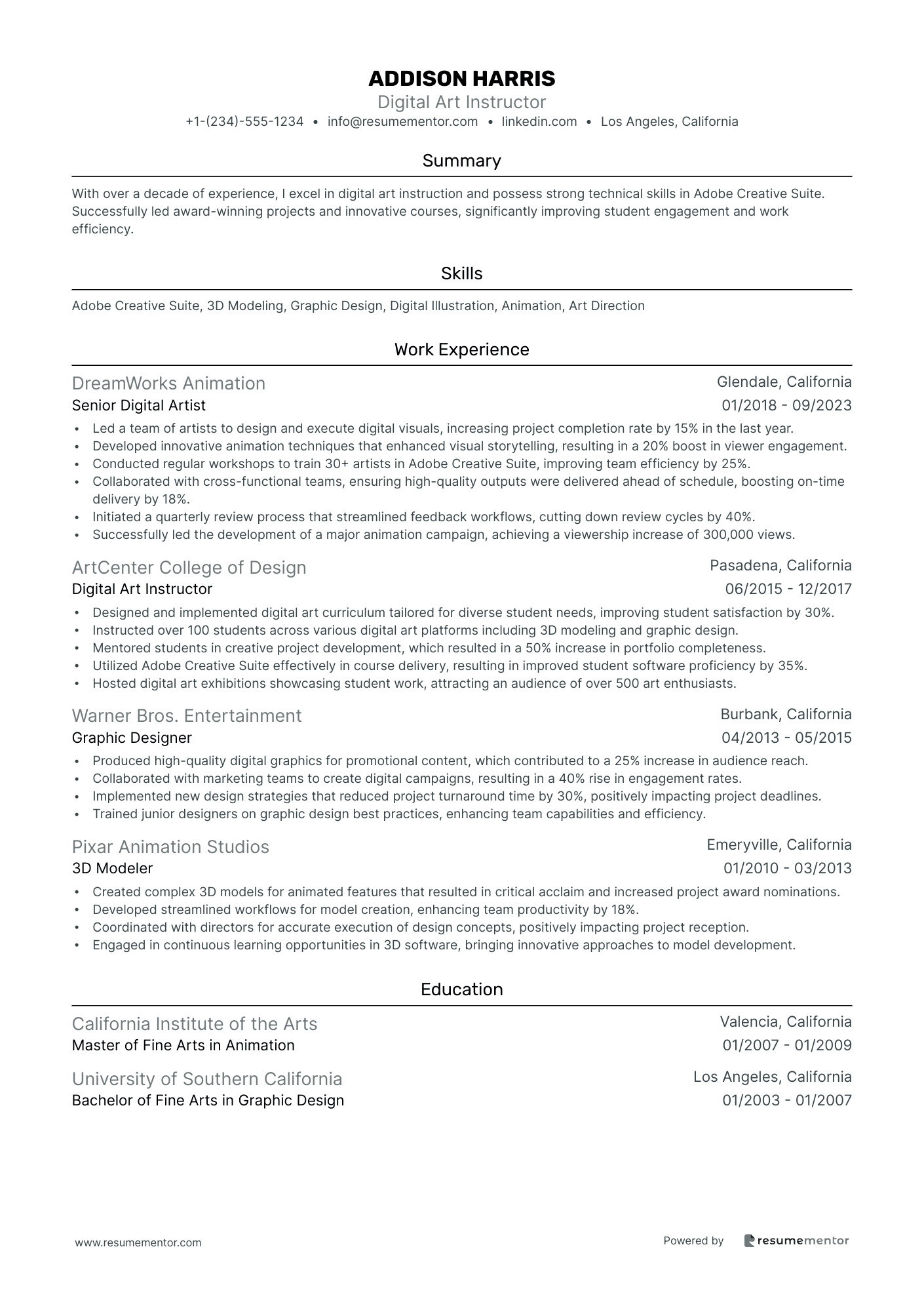
Digital Art Instructor
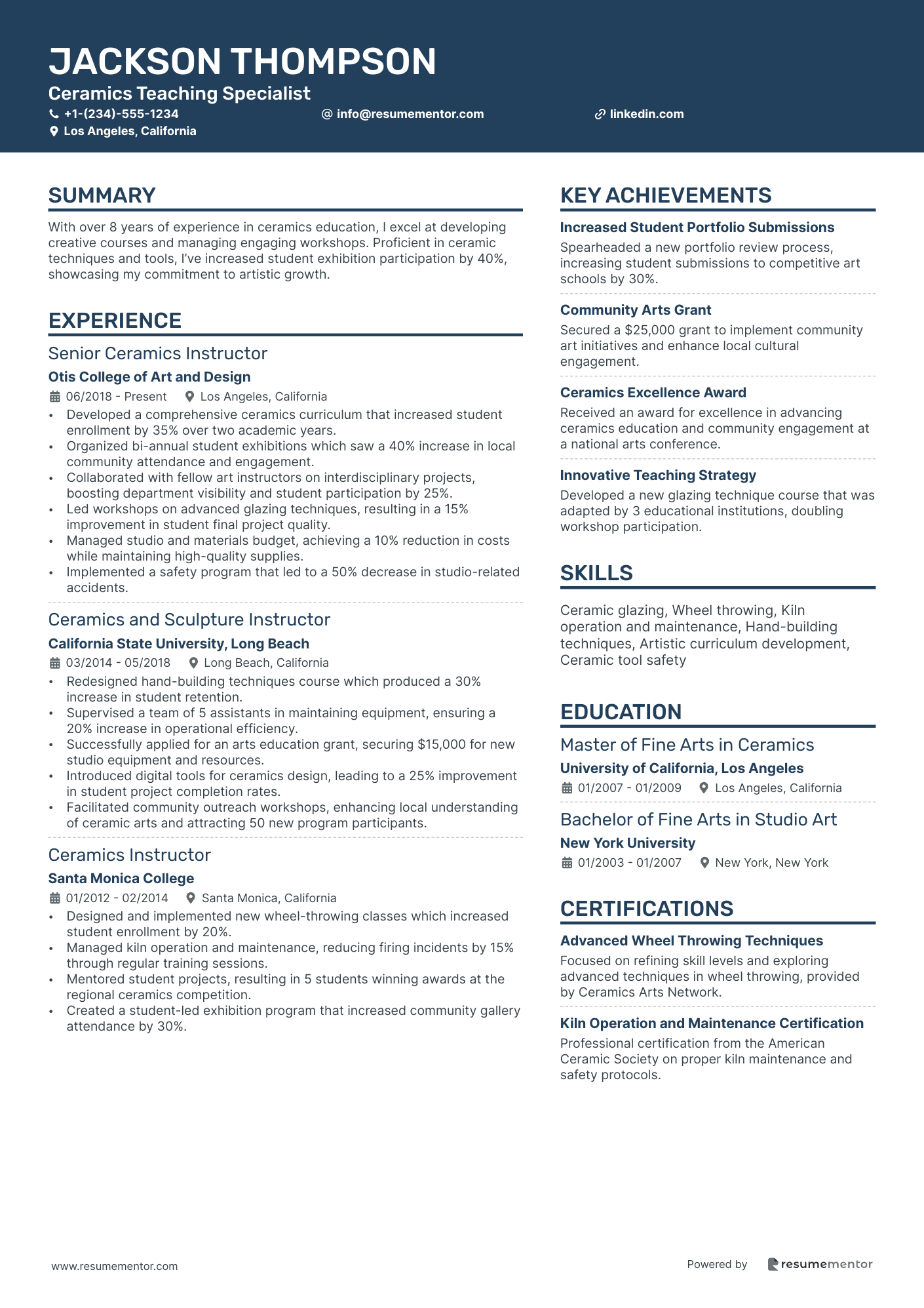
Ceramics Teaching Specialist
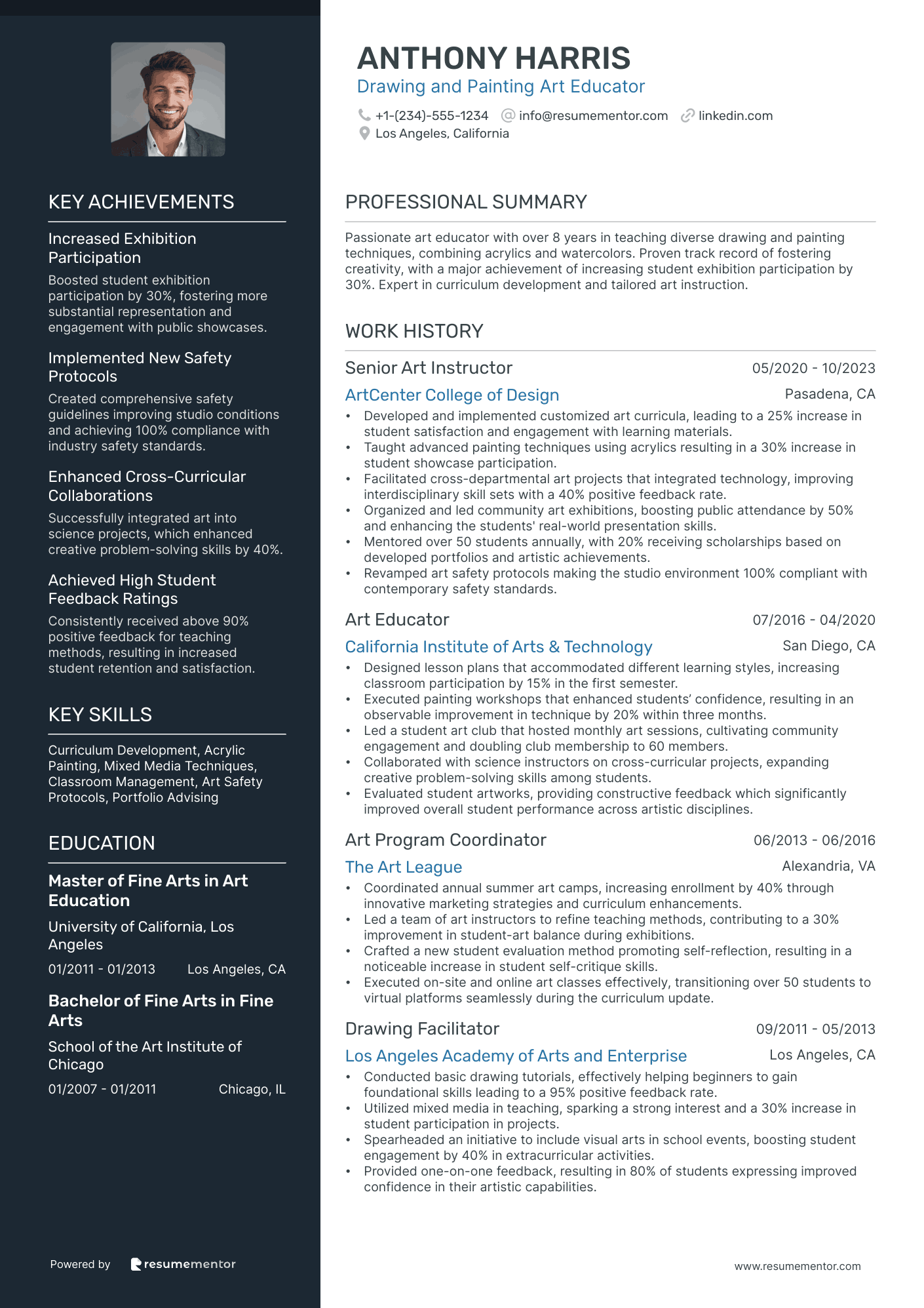
Drawing and Painting Art Educator
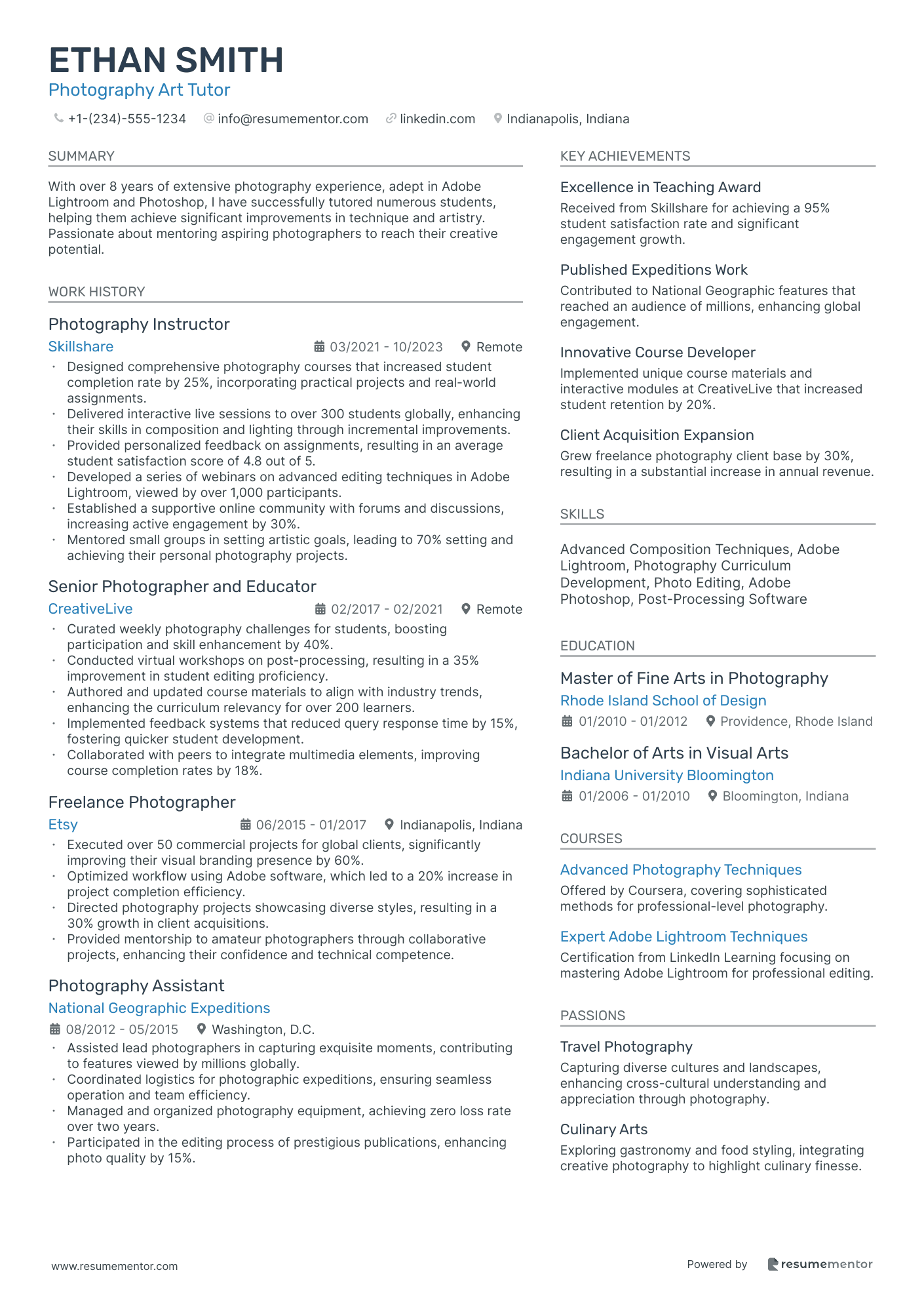
Photography Art Tutor
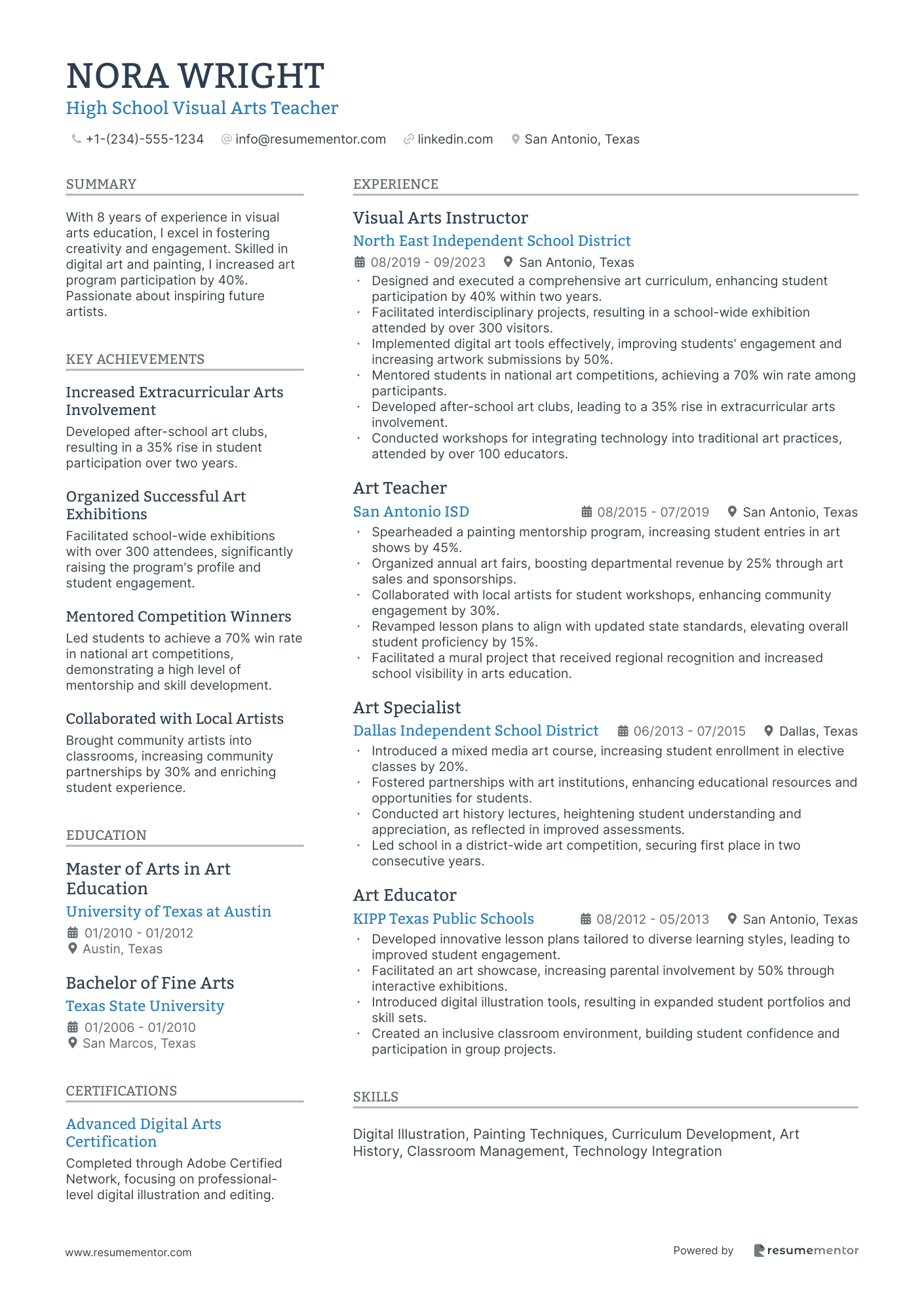
High School Visual Arts Teacher
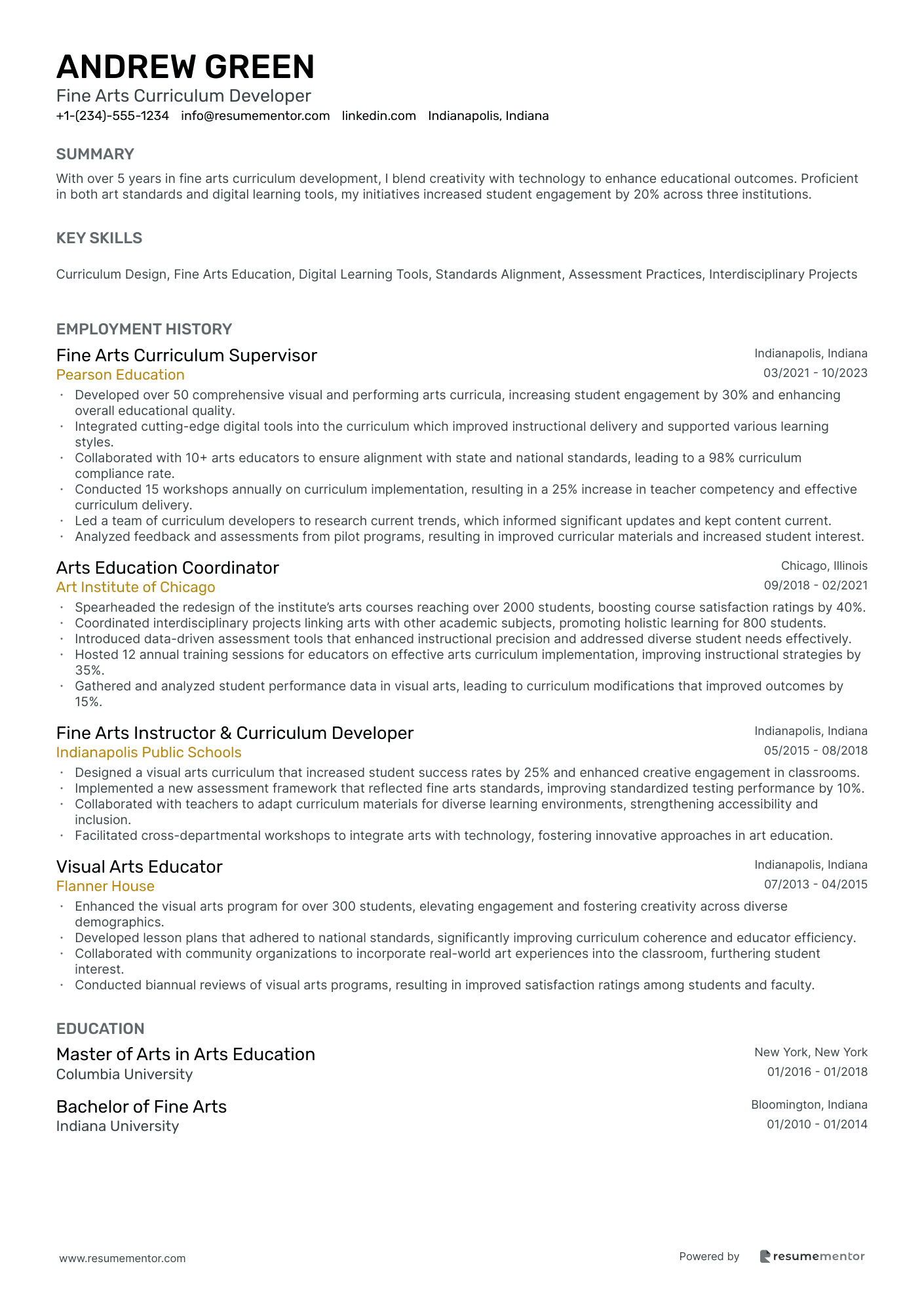
Fine Arts Curriculum Developer
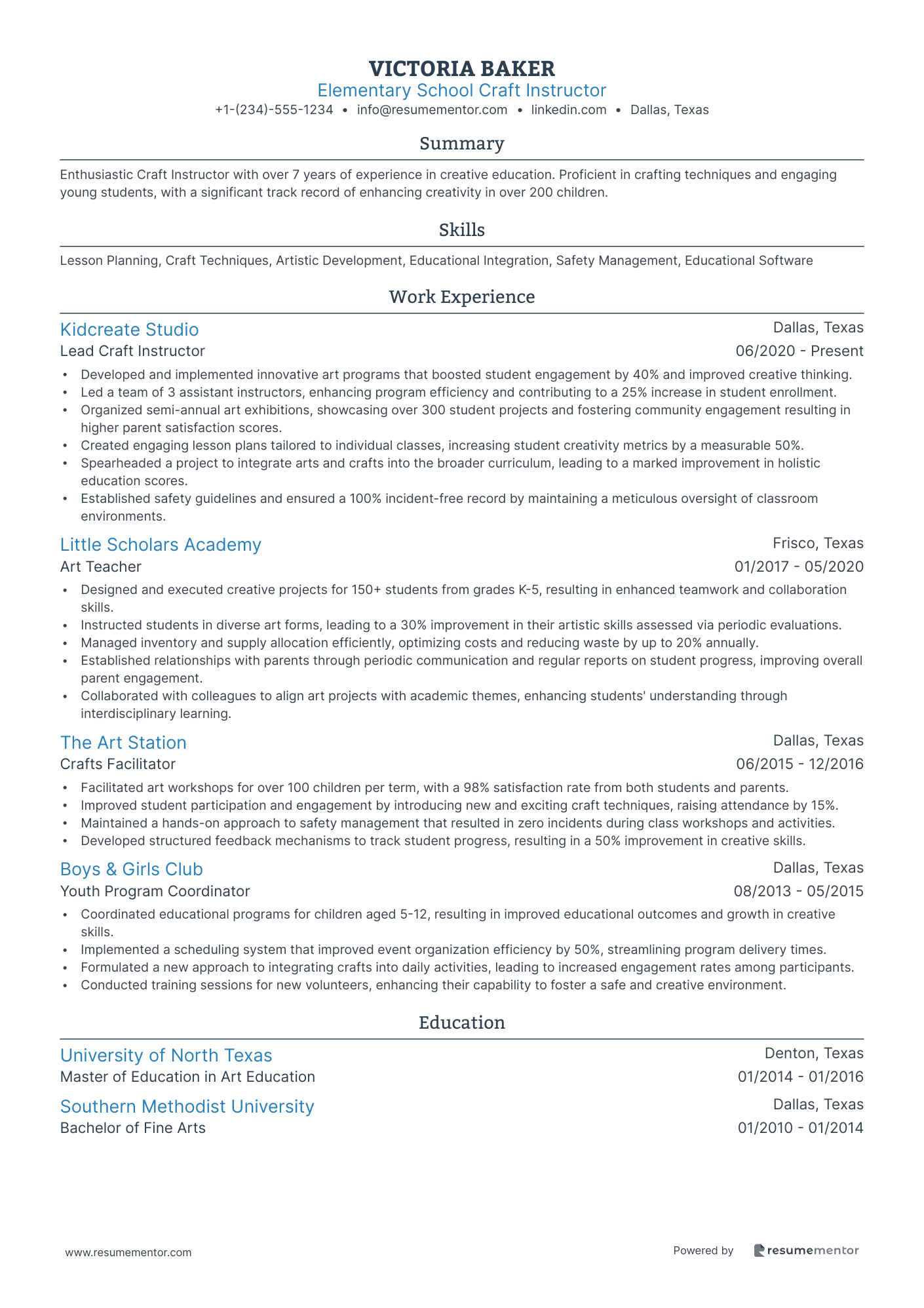
Elementary School Craft Instructor
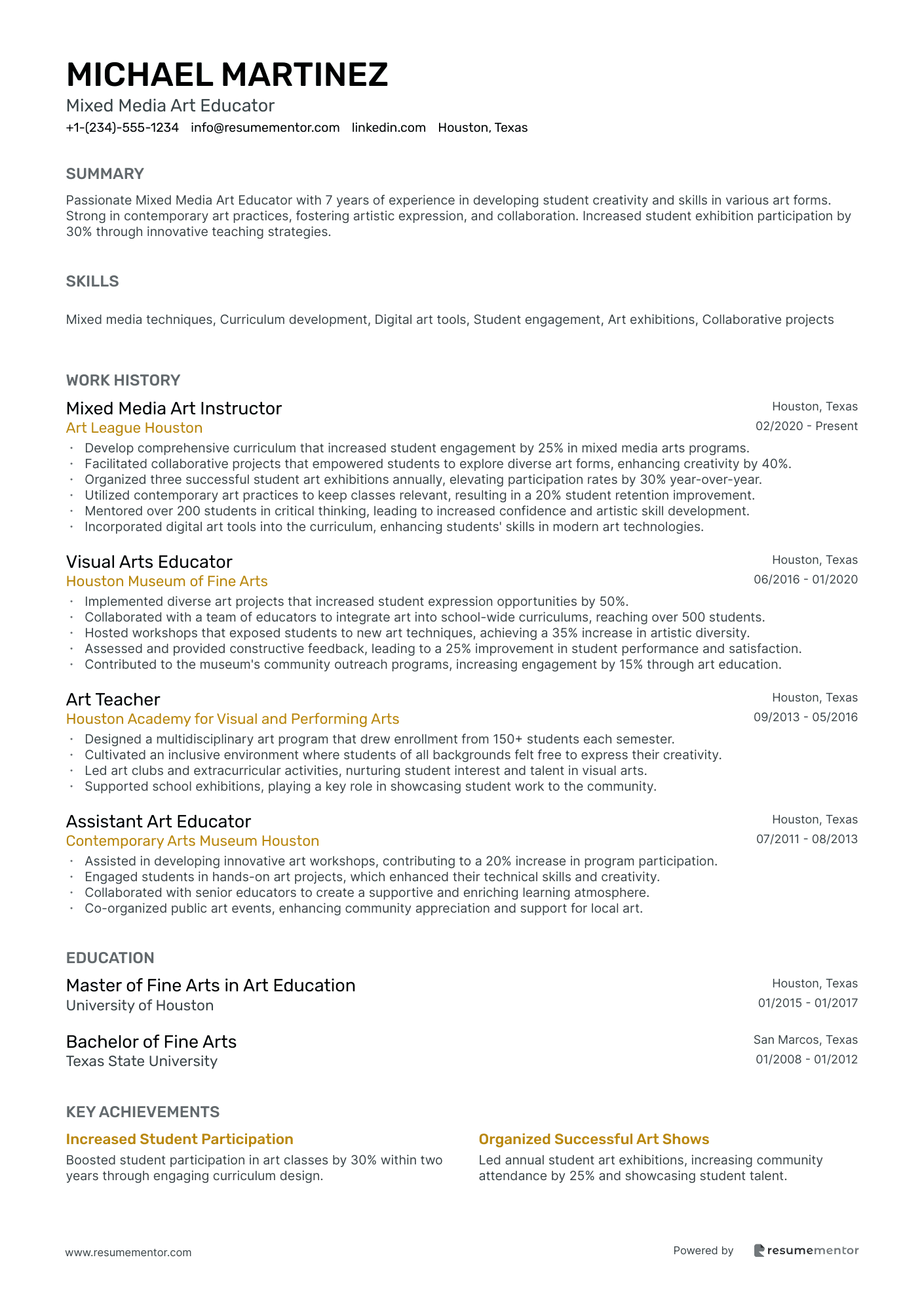
Mixed Media Art Educator
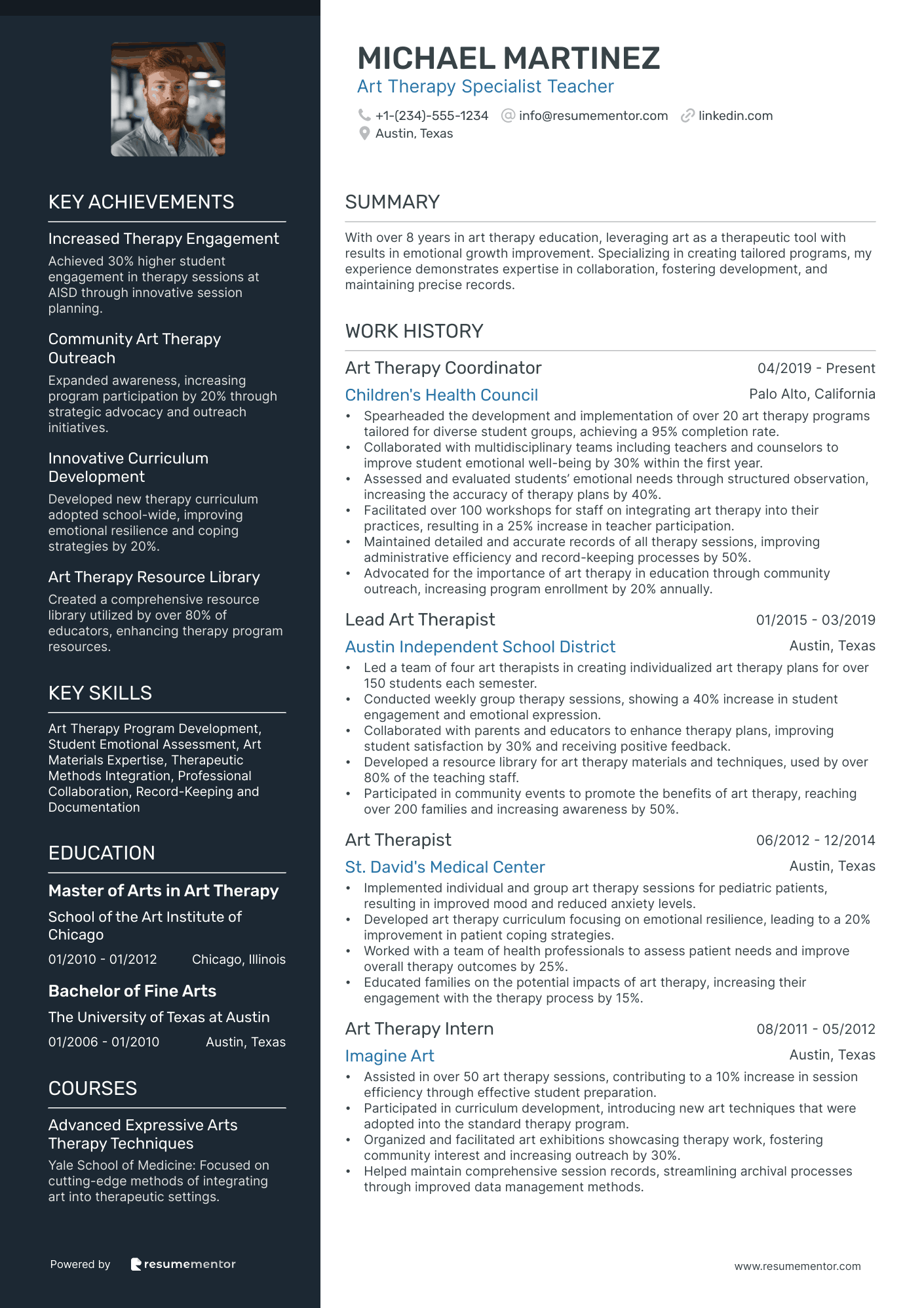
Art Therapy Specialist Teacher
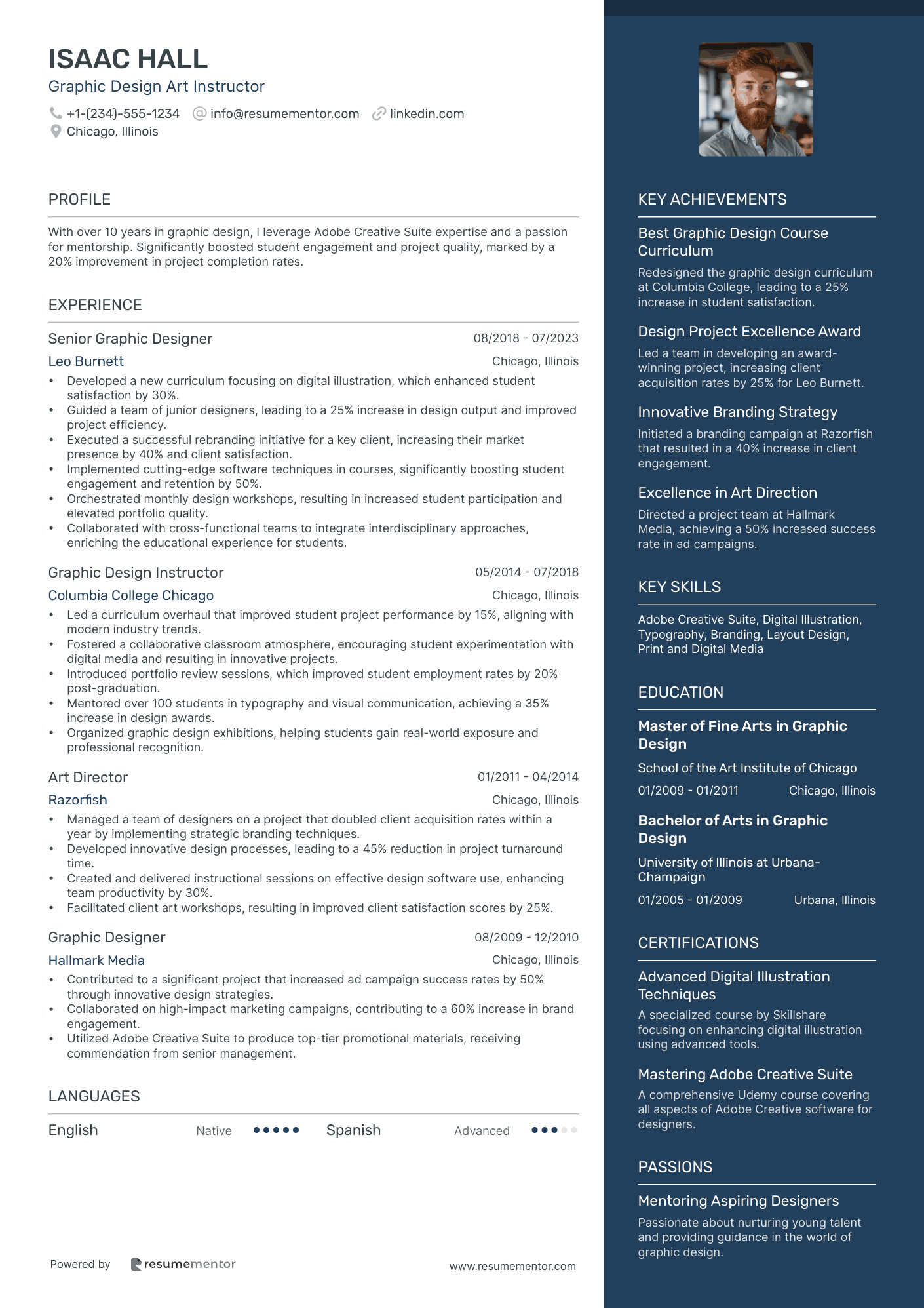
Graphic Design Art Instructor

Digital Art Instructor resume sample
- •Led a team of artists to design and execute digital visuals, increasing project completion rate by 15% in the last year.
- •Developed innovative animation techniques that enhanced visual storytelling, resulting in a 20% boost in viewer engagement.
- •Conducted regular workshops to train 30+ artists in Adobe Creative Suite, improving team efficiency by 25%.
- •Collaborated with cross-functional teams, ensuring high-quality outputs were delivered ahead of schedule, boosting on-time delivery by 18%.
- •Initiated a quarterly review process that streamlined feedback workflows, cutting down review cycles by 40%.
- •Successfully led the development of a major animation campaign, achieving a viewership increase of 300,000 views.
- •Designed and implemented digital art curriculum tailored for diverse student needs, improving student satisfaction by 30%.
- •Instructed over 100 students across various digital art platforms including 3D modeling and graphic design.
- •Mentored students in creative project development, which resulted in a 50% increase in portfolio completeness.
- •Utilized Adobe Creative Suite effectively in course delivery, resulting in improved student software proficiency by 35%.
- •Hosted digital art exhibitions showcasing student work, attracting an audience of over 500 art enthusiasts.
- •Produced high-quality digital graphics for promotional content, which contributed to a 25% increase in audience reach.
- •Collaborated with marketing teams to create digital campaigns, resulting in a 40% rise in engagement rates.
- •Implemented new design strategies that reduced project turnaround time by 30%, positively impacting project deadlines.
- •Trained junior designers on graphic design best practices, enhancing team capabilities and efficiency.
- •Created complex 3D models for animated features that resulted in critical acclaim and increased project award nominations.
- •Developed streamlined workflows for model creation, enhancing team productivity by 18%.
- •Coordinated with directors for accurate execution of design concepts, positively impacting project reception.
- •Engaged in continuous learning opportunities in 3D software, bringing innovative approaches to model development.
Ceramics Teaching Specialist resume sample
- •Developed a comprehensive ceramics curriculum that increased student enrollment by 35% over two academic years.
- •Organized bi-annual student exhibitions which saw a 40% increase in local community attendance and engagement.
- •Collaborated with fellow art instructors on interdisciplinary projects, boosting department visibility and student participation by 25%.
- •Led workshops on advanced glazing techniques, resulting in a 15% improvement in student final project quality.
- •Managed studio and materials budget, achieving a 10% reduction in costs while maintaining high-quality supplies.
- •Implemented a safety program that led to a 50% decrease in studio-related accidents.
- •Redesigned hand-building techniques course which produced a 30% increase in student retention.
- •Supervised a team of 5 assistants in maintaining equipment, ensuring a 20% increase in operational efficiency.
- •Successfully applied for an arts education grant, securing $15,000 for new studio equipment and resources.
- •Introduced digital tools for ceramics design, leading to a 25% improvement in student project completion rates.
- •Facilitated community outreach workshops, enhancing local understanding of ceramic arts and attracting 50 new program participants.
- •Designed and implemented new wheel-throwing classes which increased student enrollment by 20%.
- •Managed kiln operation and maintenance, reducing firing incidents by 15% through regular training sessions.
- •Mentored student projects, resulting in 5 students winning awards at the regional ceramics competition.
- •Created a student-led exhibition program that increased community gallery attendance by 30%.
- •Taught foundational ceramics classes to over 100 adult learners, providing personalized feedback to improve skill levels.
- •Organized yearly ceramics fairs, showcasing student work to over 200 attendees from the local community.
- •Collaborated with local schools to introduce ceramics arts programs, reaching 150 students across 3 schools.
- •Managed studio resources, ensuring a 15% cost saving over two years through strategic supply purchasing.
Drawing and Painting Art Educator resume sample
- •Developed and implemented customized art curricula, leading to a 25% increase in student satisfaction and engagement with learning materials.
- •Taught advanced painting techniques using acrylics resulting in a 30% increase in student showcase participation.
- •Facilitated cross-departmental art projects that integrated technology, improving interdisciplinary skill sets with a 40% positive feedback rate.
- •Organized and led community art exhibitions, boosting public attendance by 50% and enhancing the students' real-world presentation skills.
- •Mentored over 50 students annually, with 20% receiving scholarships based on developed portfolios and artistic achievements.
- •Revamped art safety protocols making the studio environment 100% compliant with contemporary safety standards.
- •Designed lesson plans that accommodated different learning styles, increasing classroom participation by 15% in the first semester.
- •Executed painting workshops that enhanced students’ confidence, resulting in an observable improvement in technique by 20% within three months.
- •Led a student art club that hosted monthly art sessions, cultivating community engagement and doubling club membership to 60 members.
- •Collaborated with science instructors on cross-curricular projects, expanding creative problem-solving skills among students.
- •Evaluated student artworks, providing constructive feedback which significantly improved overall student performance across artistic disciplines.
- •Coordinated annual summer art camps, increasing enrollment by 40% through innovative marketing strategies and curriculum enhancements.
- •Led a team of art instructors to refine teaching methods, contributing to a 30% improvement in student-art balance during exhibitions.
- •Crafted a new student evaluation method promoting self-reflection, resulting in a noticeable increase in student self-critique skills.
- •Executed on-site and online art classes effectively, transitioning over 50 students to virtual platforms seamlessly during the curriculum update.
- •Conducted basic drawing tutorials, effectively helping beginners to gain foundational skills leading to a 95% positive feedback rate.
- •Utilized mixed media in teaching, sparking a strong interest and a 30% increase in student participation in projects.
- •Spearheaded an initiative to include visual arts in school events, boosting student engagement by 40% in extracurricular activities.
- •Provided one-on-one feedback, resulting in 80% of students expressing improved confidence in their artistic capabilities.
Photography Art Tutor resume sample
- •Designed comprehensive photography courses that increased student completion rate by 25%, incorporating practical projects and real-world assignments.
- •Delivered interactive live sessions to over 300 students globally, enhancing their skills in composition and lighting through incremental improvements.
- •Provided personalized feedback on assignments, resulting in an average student satisfaction score of 4.8 out of 5.
- •Developed a series of webinars on advanced editing techniques in Adobe Lightroom, viewed by over 1,000 participants.
- •Established a supportive online community with forums and discussions, increasing active engagement by 30%.
- •Mentored small groups in setting artistic goals, leading to 70% setting and achieving their personal photography projects.
- •Curated weekly photography challenges for students, boosting participation and skill enhancement by 40%.
- •Conducted virtual workshops on post-processing, resulting in a 35% improvement in student editing proficiency.
- •Authored and updated course materials to align with industry trends, enhancing the curriculum relevancy for over 200 learners.
- •Implemented feedback systems that reduced query response time by 15%, fostering quicker student development.
- •Collaborated with peers to integrate multimedia elements, improving course completion rates by 18%.
- •Executed over 50 commercial projects for global clients, significantly improving their visual branding presence by 60%.
- •Optimized workflow using Adobe software, which led to a 20% increase in project completion efficiency.
- •Directed photography projects showcasing diverse styles, resulting in a 30% growth in client acquisitions.
- •Provided mentorship to amateur photographers through collaborative projects, enhancing their confidence and technical competence.
- •Assisted lead photographers in capturing exquisite moments, contributing to features viewed by millions globally.
- •Coordinated logistics for photographic expeditions, ensuring seamless operation and team efficiency.
- •Managed and organized photography equipment, achieving zero loss rate over two years.
- •Participated in the editing process of prestigious publications, enhancing photo quality by 15%.
High School Visual Arts Teacher resume sample
- •Designed and executed a comprehensive art curriculum, enhancing student participation by 40% within two years.
- •Facilitated interdisciplinary projects, resulting in a school-wide exhibition attended by over 300 visitors.
- •Implemented digital art tools effectively, improving students' engagement and increasing artwork submissions by 50%.
- •Mentored students in national art competitions, achieving a 70% win rate among participants.
- •Developed after-school art clubs, leading to a 35% rise in extracurricular arts involvement.
- •Conducted workshops for integrating technology into traditional art practices, attended by over 100 educators.
- •Spearheaded a painting mentorship program, increasing student entries in art shows by 45%.
- •Organized annual art fairs, boosting departmental revenue by 25% through art sales and sponsorships.
- •Collaborated with local artists for student workshops, enhancing community engagement by 30%.
- •Revamped lesson plans to align with updated state standards, elevating overall student proficiency by 15%.
- •Facilitated a mural project that received regional recognition and increased school visibility in arts education.
- •Introduced a mixed media art course, increasing student enrollment in elective classes by 20%.
- •Fostered partnerships with art institutions, enhancing educational resources and opportunities for students.
- •Conducted art history lectures, heightening student understanding and appreciation, as reflected in improved assessments.
- •Led school in a district-wide art competition, securing first place in two consecutive years.
- •Developed innovative lesson plans tailored to diverse learning styles, leading to improved student engagement.
- •Facilitated an art showcase, increasing parental involvement by 50% through interactive exhibitions.
- •Introduced digital illustration tools, resulting in expanded student portfolios and skill sets.
- •Created an inclusive classroom environment, building student confidence and participation in group projects.
Fine Arts Curriculum Developer resume sample
- •Developed over 50 comprehensive visual and performing arts curricula, increasing student engagement by 30% and enhancing overall educational quality.
- •Integrated cutting-edge digital tools into the curriculum which improved instructional delivery and supported various learning styles.
- •Collaborated with 10+ arts educators to ensure alignment with state and national standards, leading to a 98% curriculum compliance rate.
- •Conducted 15 workshops annually on curriculum implementation, resulting in a 25% increase in teacher competency and effective curriculum delivery.
- •Led a team of curriculum developers to research current trends, which informed significant updates and kept content current.
- •Analyzed feedback and assessments from pilot programs, resulting in improved curricular materials and increased student interest.
- •Spearheaded the redesign of the institute’s arts courses reaching over 2000 students, boosting course satisfaction ratings by 40%.
- •Coordinated interdisciplinary projects linking arts with other academic subjects, promoting holistic learning for 800 students.
- •Introduced data-driven assessment tools that enhanced instructional precision and addressed diverse student needs effectively.
- •Hosted 12 annual training sessions for educators on effective arts curriculum implementation, improving instructional strategies by 35%.
- •Gathered and analyzed student performance data in visual arts, leading to curriculum modifications that improved outcomes by 15%.
- •Designed a visual arts curriculum that increased student success rates by 25% and enhanced creative engagement in classrooms.
- •Implemented a new assessment framework that reflected fine arts standards, improving standardized testing performance by 10%.
- •Collaborated with teachers to adapt curriculum materials for diverse learning environments, strengthening accessibility and inclusion.
- •Facilitated cross-departmental workshops to integrate arts with technology, fostering innovative approaches in art education.
- •Enhanced the visual arts program for over 300 students, elevating engagement and fostering creativity across diverse demographics.
- •Developed lesson plans that adhered to national standards, significantly improving curriculum coherence and educator efficiency.
- •Collaborated with community organizations to incorporate real-world art experiences into the classroom, furthering student interest.
- •Conducted biannual reviews of visual arts programs, resulting in improved satisfaction ratings among students and faculty.
Elementary School Craft Instructor resume sample
- •Developed and implemented innovative art programs that boosted student engagement by 40% and improved creative thinking.
- •Led a team of 3 assistant instructors, enhancing program efficiency and contributing to a 25% increase in student enrollment.
- •Organized semi-annual art exhibitions, showcasing over 300 student projects and fostering community engagement resulting in higher parent satisfaction scores.
- •Created engaging lesson plans tailored to individual classes, increasing student creativity metrics by a measurable 50%.
- •Spearheaded a project to integrate arts and crafts into the broader curriculum, leading to a marked improvement in holistic education scores.
- •Established safety guidelines and ensured a 100% incident-free record by maintaining a meticulous oversight of classroom environments.
- •Designed and executed creative projects for 150+ students from grades K-5, resulting in enhanced teamwork and collaboration skills.
- •Instructed students in diverse art forms, leading to a 30% improvement in their artistic skills assessed via periodic evaluations.
- •Managed inventory and supply allocation efficiently, optimizing costs and reducing waste by up to 20% annually.
- •Established relationships with parents through periodic communication and regular reports on student progress, improving overall parent engagement.
- •Collaborated with colleagues to align art projects with academic themes, enhancing students' understanding through interdisciplinary learning.
- •Facilitated art workshops for over 100 children per term, with a 98% satisfaction rate from both students and parents.
- •Improved student participation and engagement by introducing new and exciting craft techniques, raising attendance by 15%.
- •Maintained a hands-on approach to safety management that resulted in zero incidents during class workshops and activities.
- •Developed structured feedback mechanisms to track student progress, resulting in a 50% improvement in creative skills.
- •Coordinated educational programs for children aged 5-12, resulting in improved educational outcomes and growth in creative skills.
- •Implemented a scheduling system that improved event organization efficiency by 50%, streamlining program delivery times.
- •Formulated a new approach to integrating crafts into daily activities, leading to increased engagement rates among participants.
- •Conducted training sessions for new volunteers, enhancing their capability to foster a safe and creative environment.
Mixed Media Art Educator resume sample
- •Develop comprehensive curriculum that increased student engagement by 25% in mixed media arts programs.
- •Facilitated collaborative projects that empowered students to explore diverse art forms, enhancing creativity by 40%.
- •Organized three successful student art exhibitions annually, elevating participation rates by 30% year-over-year.
- •Utilized contemporary art practices to keep classes relevant, resulting in a 20% student retention improvement.
- •Mentored over 200 students in critical thinking, leading to increased confidence and artistic skill development.
- •Incorporated digital art tools into the curriculum, enhancing students' skills in modern art technologies.
- •Implemented diverse art projects that increased student expression opportunities by 50%.
- •Collaborated with a team of educators to integrate art into school-wide curriculums, reaching over 500 students.
- •Hosted workshops that exposed students to new art techniques, achieving a 35% increase in artistic diversity.
- •Assessed and provided constructive feedback, leading to a 25% improvement in student performance and satisfaction.
- •Contributed to the museum's community outreach programs, increasing engagement by 15% through art education.
- •Designed a multidisciplinary art program that drew enrollment from 150+ students each semester.
- •Cultivated an inclusive environment where students of all backgrounds felt free to express their creativity.
- •Led art clubs and extracurricular activities, nurturing student interest and talent in visual arts.
- •Supported school exhibitions, playing a key role in showcasing student work to the community.
- •Assisted in developing innovative art workshops, contributing to a 20% increase in program participation.
- •Engaged students in hands-on art projects, which enhanced their technical skills and creativity.
- •Collaborated with senior educators to create a supportive and enriching learning atmosphere.
- •Co-organized public art events, enhancing community appreciation and support for local art.
Art Therapy Specialist Teacher resume sample
- •Spearheaded the development and implementation of over 20 art therapy programs tailored for diverse student groups, achieving a 95% completion rate.
- •Collaborated with multidisciplinary teams including teachers and counselors to improve student emotional well-being by 30% within the first year.
- •Assessed and evaluated students’ emotional needs through structured observation, increasing the accuracy of therapy plans by 40%.
- •Facilitated over 100 workshops for staff on integrating art therapy into their practices, resulting in a 25% increase in teacher participation.
- •Maintained detailed and accurate records of all therapy sessions, improving administrative efficiency and record-keeping processes by 50%.
- •Advocated for the importance of art therapy in education through community outreach, increasing program enrollment by 20% annually.
- •Led a team of four art therapists in creating individualized art therapy plans for over 150 students each semester.
- •Conducted weekly group therapy sessions, showing a 40% increase in student engagement and emotional expression.
- •Collaborated with parents and educators to enhance therapy plans, improving student satisfaction by 30% and receiving positive feedback.
- •Developed a resource library for art therapy materials and techniques, used by over 80% of the teaching staff.
- •Participated in community events to promote the benefits of art therapy, reaching over 200 families and increasing awareness by 50%.
- •Implemented individual and group art therapy sessions for pediatric patients, resulting in improved mood and reduced anxiety levels.
- •Developed art therapy curriculum focusing on emotional resilience, leading to a 20% improvement in patient coping strategies.
- •Worked with a team of health professionals to assess patient needs and improve overall therapy outcomes by 25%.
- •Educated families on the potential impacts of art therapy, increasing their engagement with the therapy process by 15%.
- •Assisted in over 50 art therapy sessions, contributing to a 10% increase in session efficiency through effective student preparation.
- •Participated in curriculum development, introducing new art techniques that were adopted into the standard therapy program.
- •Organized and facilitated art exhibitions showcasing therapy work, fostering community interest and increasing outreach by 30%.
- •Helped maintain comprehensive session records, streamlining archival processes through improved data management methods.
Graphic Design Art Instructor resume sample
- •Developed a new curriculum focusing on digital illustration, which enhanced student satisfaction by 30%.
- •Guided a team of junior designers, leading to a 25% increase in design output and improved project efficiency.
- •Executed a successful rebranding initiative for a key client, increasing their market presence by 40% and client satisfaction.
- •Implemented cutting-edge software techniques in courses, significantly boosting student engagement and retention by 50%.
- •Orchestrated monthly design workshops, resulting in increased student participation and elevated portfolio quality.
- •Collaborated with cross-functional teams to integrate interdisciplinary approaches, enriching the educational experience for students.
- •Led a curriculum overhaul that improved student project performance by 15%, aligning with modern industry trends.
- •Fostered a collaborative classroom atmosphere, encouraging student experimentation with digital media and resulting in innovative projects.
- •Introduced portfolio review sessions, which improved student employment rates by 20% post-graduation.
- •Mentored over 100 students in typography and visual communication, achieving a 35% increase in design awards.
- •Organized graphic design exhibitions, helping students gain real-world exposure and professional recognition.
- •Managed a team of designers on a project that doubled client acquisition rates within a year by implementing strategic branding techniques.
- •Developed innovative design processes, leading to a 45% reduction in project turnaround time.
- •Created and delivered instructional sessions on effective design software use, enhancing team productivity by 30%.
- •Facilitated client art workshops, resulting in improved client satisfaction scores by 25%.
- •Contributed to a significant project that increased ad campaign success rates by 50% through innovative design strategies.
- •Collaborated on high-impact marketing campaigns, contributing to a 60% increase in brand engagement.
- •Utilized Adobe Creative Suite to produce top-tier promotional materials, receiving commendation from senior management.
Crafting a compelling art teacher resume is much like painting a masterpiece—it requires precision and creativity. If your passion lies in teaching art, tackling a resume might feel daunting. You’re not alone in wondering how to mix creativity with the formal style that employers expect.
Your resume is your canvas, where showing off your artistic talents and teaching skills is crucial. Highlighting your expertise in art techniques alongside your ability to inspire students needs to translate well on paper. Without a clear structure, tying these elements together can feel like placing brush strokes without a canvas.
This is where using a resume template can make a difference. A well-organized template helps you seamlessly arrange your teaching experience, art skills, and achievements. Finding a template that suits your style can feel like discovering the perfect palette. Explore various resume templates to find one that aligns with your artistic expression while meeting professional standards.
Approach your resume with the same passion you bring to your classroom. With the right tools and a clear focus, you can create a document that perfectly captures your unique style and expertise in teaching art.
Key Takeaways
- Crafting a compelling art teacher resume is essential to showcase your artistic talents and teaching skills effectively.
- Utilizing a well-organized resume template helps integrate your experiences, achievements, and style to meet professional standards.
- The professional summary should convey your art education passion and innovative teaching methods, making you stand out as an art educator.
- It's important to narrate your teaching experience, emphasizing classroom management, lesson planning, and student engagement.
- Incorporate relevant certifications and consider adding sections for awards, exhibitions, and professional development to strengthen your presentation.
What to focus on when writing your art teacher resume
An art teacher resume should clearly convey your creative teaching skills and passion for the arts, showing the recruiter your ability to inspire and educate students effectively. Begin by making sure your contact information is current and professional—this is your first impression, and it should be easy for the recruiter to contact you.
Craft a compelling professional summary that communicates your passion for art education, including creative teaching methods and unique artistic skills. This brief overview should encapsulate your teaching philosophy and convey what makes you stand out as an art educator—your education plays a crucial role here, highlighting your academic background in art education, fine arts, or relevant fields, alongside the institutions attended and your graduation dates.
Your teaching experience section is an opportunity to narrate your journey as an art teacher, showcasing the schools you've worked at, the timeframes, and specific contributions such as integrating technology in art lessons or growing student engagement with projects like an after-school art club. Emphasizing skills relevant to art teaching is vital, as well—include your expertise in diverse art mediums, classroom management aptitude, lesson planning, and strategies for student engagement to effectively capture what you bring to the classroom.
Including your certifications will underscore your professional commitment and preparedness, whether it's a state certification or specific artist certifications relevant to your teaching role. To make your resume even more impactful, consider adding sections like "Awards and Exhibitions" or "Professional Development," illustrating how these experiences have enriched your teaching career and personal growth. Moving forward, the next section will guide you through understanding the resume format while delving deeper into what each section should highlight.
How to structure your art teacher resume
- Contact Information: Ensure your full name, phone number, email address, and location are clear and easy to find, as first impressions matter.
- Professional Summary: A concise overview that highlights your enthusiasm and innovative approaches in art education, spotlighting your teaching philosophy.
- Education: Detail your degrees in art education, fine arts, or related areas, coupled with the institutions you've graduated from and your completion dates.
- Teaching Experience: Outline your professional journey as an art teacher, with insights into schools, employment dates, and notable achievements like tech integration and student engagement initiatives.
- Skills: Focus on art-focused skills like diverse medium expertise, effective classroom management, lesson planning, and methods to drive student interest.
- Certifications: Include relevant teaching credentials, ranging from state certifications to specialized artist certifications, to underline your qualifications.
Which resume format to choose
Creating a standout art teacher resume starts with choosing the right format to effectively highlight your unique blend of creative skills and teaching experience. A functional resume is a strong choice if you want to emphasize your skills and achievements, allowing these to take precedence over simply listing job dates. This approach is particularly beneficial in art-focused roles where showcasing your talents and contributions can make a significant impact.
When it comes to fonts, opting for modern choices like Rubik, Montserrat, or Raleway adds a contemporary feel to your resume. These fonts convey creativity while maintaining clarity, mirroring the innovative and inspirational nature of an art teacher's role. Ensuring your resume consistently looks polished, regardless of where it's viewed, is crucial, so always save it as a PDF. This format keeps your design intact and readable across all devices and platforms.
For a professional and aesthetically pleasing presentation, maintaining one-inch margins on all sides is essential. This creates an inviting layout with enough white space to enhance readability without overwhelming the reader. Such attention to detail not only showcases your professionalism but also your understanding of balance and visual appeal, key traits for any art teacher.
How to write a quantifiable resume experience section
Your resume's experience section is vital for showing you're a capable art teacher. It should weave together your achievements and responsibilities fluidly, creating a narrative that aligns with the teaching job you're seeking. This section not only maps out your work history but also focuses on roles that highlight your readiness for the position. Essentially, it enables potential employers to appreciate the value you bring to their team.
Begin by listing your jobs in reverse order, placing your most recent role first. Limit your history to the last 10-15 years unless an older job offers unique relevance. Use specific job titles that mirror the roles you held, ensuring each entry feels direct and purposeful. Tailoring your resume to reflect the job ad is crucial, as it emphasizes experiences that directly connect to the role's demands. Action words like "developed," "implemented," and "enhanced" infuse your achievements with energy and impact.
Quantifiable results further enrich your narrative, providing concrete evidence of your contributions. This detailed approach helps employers visualize the difference you made. Mirroring the job ad's language underscores your suitability, as each bullet point clearly conveys your past effectiveness. It's these detailed connections that make your experience section compelling.
- •Increased student participation in art club by 40% through community art projects.
- •Enhanced curriculum by integrating digital art tools, resulting in a 30% boost in student engagement.
- •Organized annual art shows attracting over 500 visitors and increasing school funding by 20%.
- •Developed tailored lesson plans to accommodate various learning styles, improving overall class performance by 15%.
This example stands out by weaving your achievements into a coherent story that directly matches job qualifications. Every bullet begins with active verbs like "increased," "enhanced," and "organized," giving the points positive momentum. Instead of merely listing tasks, it paints a vivid picture of your substantial impact at Sunrise Middle School. As the section seamlessly ties your past accomplishments to potential future contributions, it assures employers of your capability to fulfill their needs effectively. By carefully aligning with the job's demands, your experience becomes a compelling testament to your potential as an ideal candidate.
Achievement-Focused resume experience section
A focus on achievements in your art teacher resume experience section will showcase your impact and contributions effectively. Start by briefly describing your role in the school setting, using specific numbers or outcomes to make your accomplishments stand out. Highlight how your efforts led to positive changes, both in student engagement and overall program success, instead of just listing duties. This approach will help potential employers see the unique value you bring as an art teacher.
To create a standout experience section, begin with a clear job title followed by your role at the school. Use bullet points to highlight your innovative contributions, such as designing new curricula or organizing successful events, and explain their effects on students and the school community. Mention tangible outcomes, like increased student participation or achievements in competitions, as they illustrate your creativity and dedication. This method showcases your proactive nature and the positive impact you've had, making your resume stand out.
Art Teacher
Springfield High School
August 2018 - June 2023
- Designed an interdisciplinary art curriculum that increased student participation by 30%.
- Organized an annual school art festival, attracting over 500 visitors and showcasing student talent.
- Introduced digital art tools, resulting in 40% of students exploring new mediums.
- Facilitated local community art projects, enhancing school-community relationships.
Skills-Focused resume experience section
A skills-focused art teacher resume experience section should effectively showcase the unique talents and innovative approaches you bring to the classroom. Begin by highlighting your main responsibilities and achievements, emphasizing the skills that enabled your success. Provide concrete examples that illustrate your creativity and adaptability in engaging students with art. This might include sharing how specific teaching methods or projects have significantly sparked your students’ interest and enthusiasm.
To make your bullet points impactful, use clear language to depict how you’ve applied your teaching skills and worked collaboratively with colleagues. Highlight any group projects you initiated and your successful teamwork. If you’ve earned recognition or awards for your contributions, be sure to mention these accolades to stand out as an exceptional art teacher. By weaving your skills and achievements into a cohesive narrative, you can effectively demonstrate how you’ve enhanced students’ learning and classroom experience.
Art Teacher
Sunnyvale Middle School
August 2018 - Present
- Developed engaging art curricula for students from diverse backgrounds, fostering a love for creativity and self-expression.
- Implemented an art club that increased student participation and showcased their talents in an annual school exhibition.
- Collaborated with fellow teachers to integrate art projects with core subjects, enhancing cross-curricular learning.
- Received the 'Excellence in Teaching' award for innovative approaches in art education.
Responsibility-Focused resume experience section
A responsibility-focused art teacher resume experience section should clearly showcase your major duties and the impact you have in your role. Start by describing how you manage the classroom, create engaging lesson plans, and nurture students' creativity. Rather than listing duties, illustrate how you have shaped the learning environment and inspired students to explore their artistic talents. Use active verbs to highlight your part in maintaining a positive and encouraging atmosphere, ensuring that each sentence builds on the last.
Emphasizing your responsibilities demonstrates your reliability and capability to potential employers. Be sure to include specific achievements or projects that reflect your passion for teaching and art. For example, if you organized an art exhibition, discuss its purpose and how it benefited your students, connecting it back to your overall teaching approach. This approach not only highlights your teaching expertise but also underscores your commitment to guiding students in their artistic journeys.
Art Teacher
Riverside High School
August 2018 - Present
- Developed comprehensive art curriculum that increased student engagement by 30%.
- Organized annual art exhibitions involving over 200 student artworks.
- Implemented a classroom management system that improved student focus and participation.
- Mentored students in portfolio development, leading to 10 students being accepted into art schools.
Customer-Focused resume experience section
A customer-focused art teacher resume experience section should highlight your ability to connect with students while maintaining a nurturing learning environment. Begin by sharing how you've adjusted your teaching methods to cater to various learning styles, incorporating flexible lesson plans and creative techniques. This approach not only makes lessons engaging but also prioritizes student creativity. Include specific achievements, such as improved student performance or recognition from peers, to demonstrate your impact.
It's equally important to showcase how you build strong relationships with students and colleagues. Describe how you've established a classroom atmosphere where support and constructive feedback are the norms and progress is celebrated. By including examples of collaborations with parents or the community, you illustrate your commitment to the broader educational landscape. Use straightforward language to emphasize your dedication to helping students grow, ensuring your accomplishments are both clear and compelling.
Art Teacher
Springfield Elementary School
August 2018 - Present
- Developed adaptive lesson plans that increased student engagement by 30%.
- Fostered a supportive learning environment that improved student feedback ratings by 25%.
- Led after-school art clubs, enhancing students' creative abilities and confidence.
- Collaborated with parents and community members to organize annual art showcases.
Write your art teacher resume summary section
A teaching-focused art teacher resume summary should seamlessly convey your passion and expertise. Begin by showcasing your achievements, skills, and teaching philosophy in a concise manner. This opening section serves as your first impression, making it crucial that it's both memorable and specific. It should reflect your dedication to fostering creativity and nurturing an inclusive learning environment. For example:
This summary paints a cohesive picture of a candidate passionate about art and education. Their experience and approach to teaching shine through, making them an excellent fit for an art teaching position. On the other hand, if you’re just beginning, a resume objective can highlight your goals and what you aim to achieve. While a summary highlights past successes and skills, an objective focuses on future aspirations. A resume profile offers a broad overview, and a summary of qualifications lists specific competencies. Each serves a different purpose, but all should be concise and aligned with the job. Craft your summary or objective to fit the role, showcasing your most relevant skills and career goals.
Listing your art teacher skills on your resume
A skills-focused art teacher resume experience section should artfully highlight your competencies to capture a potential employer’s attention. You can choose to showcase your skills in a standalone section or integrate them into other parts of your resume, such as the experience and summary sections. Including both your strengths and soft skills can effectively demonstrate your ability to interact with others in educational settings. Equally important are your hard skills, which are specific abilities you’ve developed through training or experience, like painting or digital design. Carefully selecting the right words to describe these skills and strengths can transform them into powerful resume keywords, making your resume shine.
Here’s how you might list your skills in a standalone section:
This particular skills section works effectively by listing capabilities that are directly relevant to teaching art. Each skill is aligned with potential tasks and responsibilities, making it easy for a hiring manager to envision your role in their setting.
Best hard skills to feature on your art teacher resume
To effectively teach and inspire students, art teachers need to have a set of robust hard skills. These skills demonstrate your ability to handle various art methods and teaching strategies. Here are 15 essential hard skills for art teachers:
Hard Skills
- Art Instruction
- Curriculum Development
- Classroom Management
- Digital Design Proficiency
- Drawing
- Painting
- Sculpting
- Printmaking
- Art History Knowledge
- Photography
- Adobe Creative Suite Proficiency
- Ceramics
- Graphic Design
- Mixed Media Art
- Visual Arts Integration
Best soft skills to feature on your art teacher resume
On the other hand, soft skills are key for art teachers to communicate, motivate, and engage students. These skills reflect your ability to connect with both students and colleagues on a personal level. Consider featuring these 15 soft skills on your resume:
Soft Skills
- Communication
- Patience
- Creativity
- Adaptability
- Problem-solving
- Organization
- Collaboration
- Motivation
- Empathy
- Time Management
- Critical Thinking
- Conflict Resolution
- Leadership
- Active Listening
- Positivity
How to include your education on your resume
An education section is an essential part of your resume, especially if you're an art teacher. Tailoring this section to the job you're applying for boosts your chances of making a strong impression. Include only the most relevant educational experiences for the position. Leave out any degrees or coursework unrelated to art education. If you have a strong GPA, you should consider including it on your resume, but only if it's above 3.0. For those who graduated with honors, such as cum laude, highlight this achievement right after your degree. When listing a degree, state the type, such as Bachelor of Arts, followed by your major.
Here's an example of what not to do:
Contrast this with a well-tailored example for an art teacher:
This example is effective because it emphasizes a high-level degree specifically in art education. Including "cum laude" signals excellence and dedication, while the GPA showcases academic strength. This relevant education helps to position you as a well-qualified candidate for an art teaching role. The example ensures your qualifications are front and center, making it easy for hiring managers to see your fit for the job.
How to include art teacher certificates on your resume
Including a certificates section on your art teacher resume is crucial. Certificates show your qualifications and dedication to professional growth. List the name of each certificate clearly. Include the date you received each certificate to show your timeline of continuous learning. Add the issuing organization to validate the authenticity of your certificates. Placing certificates in the header can quickly showcase your qualifications.
Example:
This example is strong because it highlights certificates relevant to the art teaching profession. Each certificate is specific, making your qualifications clear. Additionally, the issuing organizations are well-known and respected, adding credibility. The timeline shows a commitment to ongoing education. This thorough yet concise approach ensures potential employers quickly grasp your expertise.
Extra sections to include in your art teacher resume
Crafting a resume for an art teacher can be a fulfilling endeavor when you are drawn to educating and inspiring students through creative expression. Including additional sections can help highlight your varied abilities and your engagement with the art community.
- Language section — Highlight any languages you are proficient in to show your versatility and ability to engage with more students. This can be particularly beneficial in diverse educational environments.
- Hobbies and interests section — Highlight your hobbies and interests to provide a fuller picture of who you are, showing interviewers your passion for art beyond the classroom. Engaging in artistic activities outside of teaching demonstrates your commitment to continual practice and learning.
- Volunteer work section — Showcase your volunteer experience to illustrate your dedication to community and service. Providing art workshops for underprivileged communities can highlight your teaching skills in diverse settings.
- Books section — List relevant books that show your engagement with art history, education methods, or other relevant topics. Sharing that you have read influential art theory texts, for instance, can demonstrate your academic interest and continuous learning in the field.
In Conclusion
In conclusion, creating an effective art teacher resume is a thoughtful blend of showcasing your skills, achievements, and passion. Your resume should tell a story, painting a clear picture of your journey as an art educator. Using a resume template can help organize this information, ensuring that each element of your experience stands out. Focus on clearly presenting your art techniques, teaching expertise, and any notable achievements. Highlight your ability to inspire students through creative learning methods. Ensure every section, from education to skills, supports your overall candidacy with specific examples. Conveying your passion for art and education will make you relatable and memorable to potential employers. Through careful crafting, your resume can become a strong reflection of your professional identity. Remember to choose a format and font that reflects your style yet remains professional. Whether you're experienced or just starting, aligning your resume with the job description will enhance its effectiveness. Ultimately, a well-crafted resume not only opens doors but also sets the stage for you to inspire the next generation of artists.
Related Articles

Continue Reading
Check more recommended readings to get the job of your dreams.
Resume
Resources
Tools
© 2026. All rights reserved.
Made with love by people who care.

